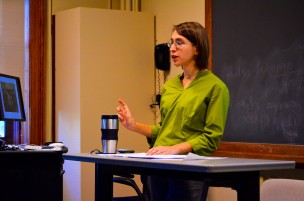Students gathered to hear a lecture by Associate Professor of Sociology at Williams College Olga Shevchenko on Oct. 14. The topic was the construction of space in the Soviet era, but the speaker used an unusual medium to explore it: travel photography.
Shevchenko received her bachelor’s degree from Moscow State University, her master’s from Central European University, and her Ph.D. from University of Pennsylvania. She currently teaches at Williams College with a focus in post-socialism and how it functions in every day life. She has many publications on topics ranging from interpretations of Karl Marx to post-socialist Moscow to amateur photography’s relation to state violence.
Throughout the lecture, Shevchenko used a slideshow of photos from family albums of the Soviet Era and combined them with anecdotes to support her thesis. She argued that subsidized travel was a tool of the government that helped normalize the space of the entire Soviet Union.
Shevchenko began the lecture by explaining the background of traveling in the Soviet Union: the government allowed many of its workers, including janitors and other blue-collar workers, to vacation at very discounted prices to many areas around the continent. These included popular cities such as Moscow and Kiev, as well as beach resorts in the South or Siberia to the North.
“Leisure and ability to travel were also forms of entitlement,” Shevchenko said. “Traveling was part and parcel of being Soviet.”
One striking aspect about all of these pictures, Shevchenko noted, was that they were often taken of large groups of strangers.
“The visual similarity of the people populating group travel photos…implied a generic Soviet lifestyle, naturalizing the stretch of Soviet civilization, both in a geographical and also in a cultural sense,” Shevchenko said.
Shevchenko observed that such group photos were surprisingly similar in composition. Even in photos taken in amusement parks, the subjects were dressed in business-casual attire and rarely smiled.
“People don’t acknowledge in any way the comical nature of the backdrop and stand with the same kind of somber air as they would in any other group photograph,” she said.
Shevchenko’s key argument was that the Soviet Union’s subsidized travel created and reinforced this notion of a united Soviet space, despite the geographical and cultural diversity. From Central Asian states to the Balkans, the average Soviet citizen had complete access to all of this land. This concept, she believes, is well represented in amateur photography.
“In this respect, socialism’s visual project may have succeeded,” Shevchenko said.
Throughout the lecture, there was a focus on amateur photography as an important sociological tool for understanding what the state meant to the common person. The photographs all came from private family albums from five Russian cities. Shevchenko’s team asked all three generations about the pictures in order to understand what it meant to each individual family member.
“We tended to ask people to show the albums they care most about because otherwise we knew we would be there for days,” Shevchenko said. “I think for a lot of these people it was a meaningful occasion to jointly look at the family albums and talk to someone who has an interest [in them].”
Many of those who attended found the lecture fascinating and chuckled at some of the more humorous photos in the collection.
“It was interesting to learn how much the Soviet Union’s ideologies are manifested in something as small as a family photo album,” said Sadichchha Adhikari ’16. “This is probably one of the most unique lectures I’ve seen at Wesleyan.”
The University’s Russian program has expanded to become more interdisciplinary; this lecture reflected the program’s efforts to mirror this in the speakers it chooses.
“We were looking to have lectures that incorporated our many disciplines together,” said Chair of Russian Language & Literature and Associate Professor of Russian, East European, and Eurasian Studies Priscilla Meyer. “Olga [Shevchenko] combines anthropology and sociology….She is a wonderful example of the interdisciplinary work that we hope to pursue.”
Meyer hopes to have more lectures on topics such as these, so more students can realize the many different kinds of topics that are covered under Russian, East European, and Eurasian Studies.
“Our field is changing from being predominantly Russian literary studies to focusing more on these social science kinds of fields,” she said.

Comments are closed